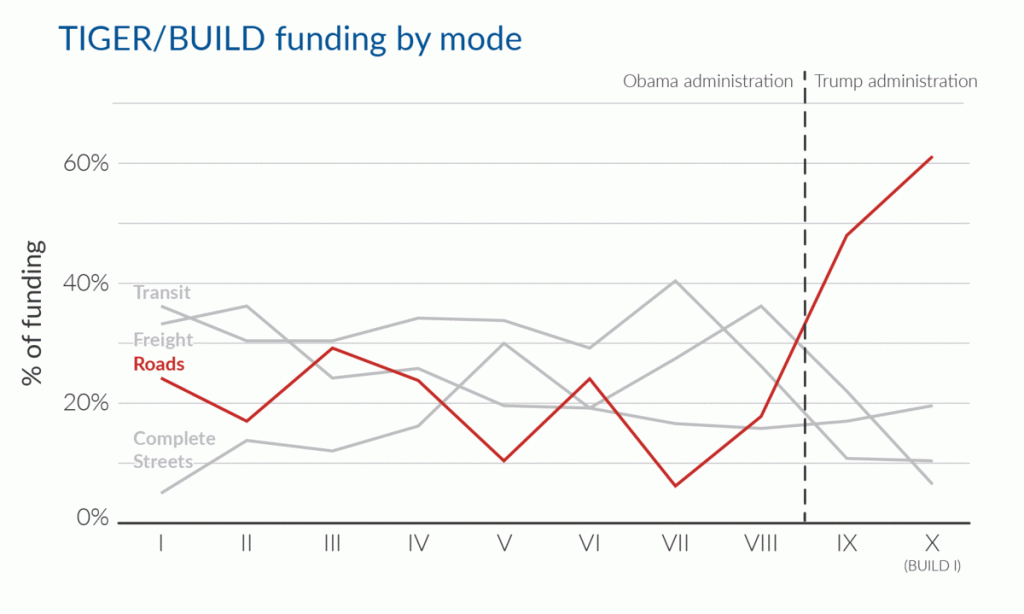Trump’s USDOT BUILDs even more roads
Federal grants for multimodal projects announced this month are decidedly not multimodal. As our research has shown previously, the Trump administration has dramatically undermined this grant program by funding traditional road projects that could otherwise already be funded by states, siphoning resources from other, harder to fund projects—the original intent of the program. But the U.S. House has adopted some policy changes to try and salvage some of what made the BUILD program so popular under the Obama administration.
Recently, the U.S. Department of Transportation (USDOT) announced $900 million in BUILD grants to fund transportation projects around the county. Unlike many federal grant programs, BUILD grants are uniquely flexible—any government entity can apply for funding on almost any kind of transportation project, making worthy multimodal projects and complicated projects that cross jurisdictions easier to pay for.
The BUILD program was created under the Obama administration—and originally named TIGER—but after taking over, the Trump administration has more or less ignored this unique flexibility and turned the program into a subsidy for run-of-the-mill road projects that could be built with some of the billions states get each year for roads and highways. The awards released two weeks ago are further evidence of this trend.
We explored these changes last year with an in-depth analysis showing how the Trump administration has dramatically shifted priorities.
In the two most recent rounds of TIGER/BUILD awards—the first two years the program was managed by the Trump administration—only about 10 percent of funding went to transit projects. This is a big departure from the previous eight years when transit projects received between 28 and 40 percent of funding. Conversely, the share of funding dedicated to traditional road projects has grown to all-time highs; in 2018, road projects—most of which are eligible to receive normal formula dollars from their state—received more than 60 percent of the funding for the first time, after hovering below 30 percent for years.
2019 is just more of the same. According to a quick analysis of the projects selected, more than 70 percent of the funding went to conventional road and bridge projects—a huge share for a program still billed as an opportunity “to obtain funding for multi-modal, multi-jurisdictional projects that are more difficult to support through traditional DOT programs.”
But these changes haven’t gone unnoticed. In that same analysis—Taming the TIGER—we included some simple policy recommendations for Congress to fix the BUILD/TIGER program specifically and to improve the federal transportation program broadly. Some of these recommendations have been taken up by the U.S. House in their most recent annual transportation funding bill. Among the changes we’ve advocated for are:
- A set aside of $15 million for planning grants and requiring the USDOT secretary to award planning grants with an emphasis on transit, transit-oriented development, and multi-modal projects.
- A doubling of the maximum award to $50 million.
- A consideration of project benefits beyond its physical location in an urban or rural area to the fullest extent to include all relevant geographic areas.
These are good recommendations, but they were not included in the Senate’s version of this annual transportation funding bill. For the House language to be included in the final bill, it needs to be accepted in the conference committee when the House and Senate reconcile the differences in their bills.
When Congress finally passes their funding bills (repeatedly hung up due to disagreement about funding for a border wall), incorporating the House’s proposed changes to the BUILD program will help it accomplish its stated goals despite the administration’s efforts to use it as a way to give states just a little bit more money to spend on the same old projects.





















1 Comment